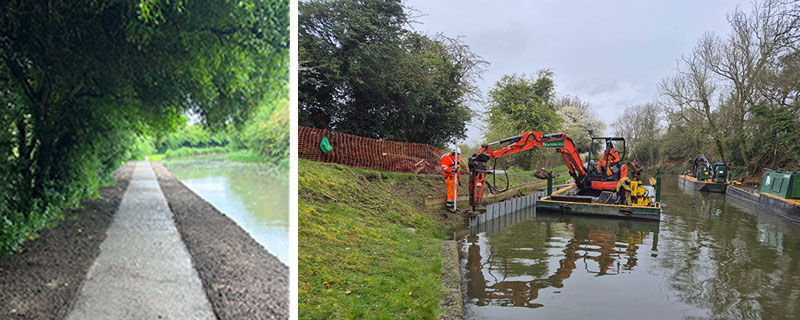NOT GOING TO BREAK THE BANK
Overflows from an adjacent river into the Grand Union Canal had increased water pressure in one of the waterway’s locks, damaging nearby banks and towpaths. With the possibility of the river and canal merging becoming increasingly likely, The Rothen Group stepped in to mitigate this risk.
The Grand Union Canal is the longest canal in the UK, running 137 miles from the Thames to Birmingham. Its connecting Leicester Line is also highly important, providing a 41-mile route linking the main waterway to routes across Derbyshire, Staffordshire and Cheshire. Crucial to this is the Line’s link to the River Soar, with boaters joining a stretch of canalised river at Leicester, before carrying on to the River Trent and eventually the Trent & Mersey Canal.
Consequently, the River Soar is highly significant to the country’s waterway infrastructure, while also providing a scenic route for narrowboats along quiet meadows and picturesque villages. However, the canalised portion of the river was under threat following extreme weather events over this winter and spring.
Overflows and Overtopping
High levels of rainfall over multiple months had caused the main river to overflow, resulting in overtopping into the adjacent canal. Though the immediate flooding stemming from this phenomenon is a disruptive issue by itself, its impact on waterway infrastructure is even greater still.
After a member of the public drew down the section between Lock 37 and Lock 38 to create a barrier between the overflowing River Soar and nearby properties, water pressure supporting the pilings dropped. In turn, the sides of the canal could no longer withstand the strain from the overflowing river water and subsequently flooding into the empty canal. As a result, damage occurred to the canal walls and towpath that required immediate attention.
If this existing bank protection were to fail completely – a distinct possibility, considering the increasing frequency of extreme weather events – the risk of the canal and larger River Soar bleeding into each other would increase. The impact of this merge would be huge for the villages and communities dotting the waterway, as an ensuing build-up of silt in the expanded river would lead to more flooding in the area.
Site Challenges
The Canal & River Trust, the charity responsible for the upkeep of the UK’s waterways, engaged Jackson Civil Engineering (Jackson) to carry out urgent repair works and prevent a worsening situation. The project site presented immediate challenges for Jackson. Namely, any bank restoration works had to be carried out on a remote stretch of canal that was not navigable by land-based construction machinery.
Taking this into account, the company contacted marine engineering specialists The Rothen Group (TRG) to implement an effective solution, designed by the Trust. The design saw improvements across one 30m and two 25m sections as well as along a 60m non-failed stretch. This included replacing the waling bar, tie backs and back piles. These renovated canal walls would then be backfilled with clay, soil and stone to restabilise the towpath after damage caused by increased water pressure from the lock.
Major works were carried out by a five-tonne digger situated on an adjustable, stabilised pontoon on the waterway. Alongside this, a tug boat and hopper were used to assist in the removal of previous bank protection via the canal. This floating plant machinery was also used in the final step of the project – the installation of new mooring bollards to invite more waterway users from the area.
Removing the Risk
Though the return of boaters to the affected area was undoubtedly pleasing to TRG Founder Ian Rothen, he is keen to emphasise the structural and environmental importance of these works.
“Sections of canalised river do not only offer boaters a convenient way to navigate much-loved boating routes,” he explains. “The towpaths and banksides around these waterways also provide flood protection for the nearby area.
“Consequently, the erosion of canal walls in these areas can have a catastrophic effect on local housing and businesses. Had these works not been carried out, more of the bank would have crashed and led to a real risk that the river and canal would merge. Had this happened, the buildup of silt in the river would have majorly disrupted life in the area for the foreseeable future.
“By successfully completing this project, we have been able to avert this situation. As they say, prevention is better than the cure, and this remediation and maintenance work will undoubtedly help safeguard the surrounding community for years to come. This is some of the most important work that we do, and we are thankful to Jackson Civil Engineering for engaging our services here.”









Leave a Reply
Want to join the discussion?Feel free to contribute!